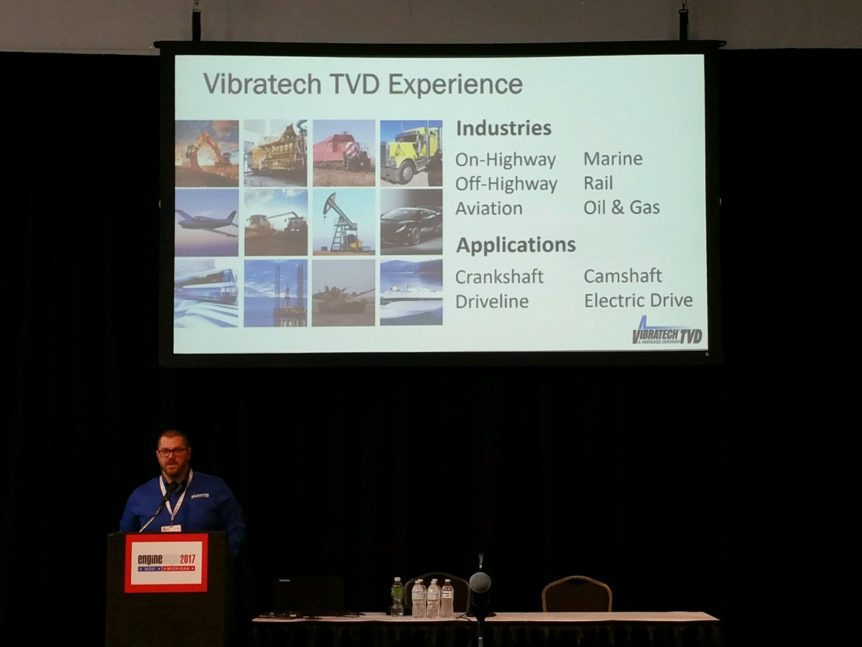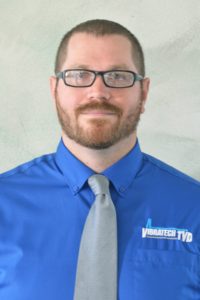2018 Engine Expo – Novi is approaching. The premiere North American showcase for the latest in engine technology takes place Oct. 23-25. Held at the Suburban Collection Showplace in Novi, Michigan. Join Vibratech TVD, the parent division of Fluidampr, at booth #E400.
Vibratech TVD Product Engineering & Vibration Solutions Manager, Aaron Neyman is also honored to present “Lightweight Viscous Dampers in High Temperature, High Performance Engines.” during the show’s Open Technology Forum.
While you’ll need to attend the forum to learn the insights first hand, we (FD) did catch up Mr. Neyman as he prepares for it.
QUICK 5 WITH AARON NEYMAN
FD: What’s your definition of a high performance engine? What’s your experience?
Neyman: A high performance engine would consist of a high compression ratio, lightweight rotating assembly, and increased horsepower per liter ratio. Generally designed to run at high rpm.
From our Fluidampr side we have extensive experience in motorsports since the product was launched in 1985. It is exclusively a high performance viscous damper. Typically used on race applications. We also have OEM automotive and marine factory endurance racing use. Last, there are OEM supercar and hypercar viscous damper developments.
FD: You’ve been very influential in the advancement of viscous dampers at Vibratech TVD over the past nine years. How have the demands placed on torsional dampers in high performance engines changed?
Neyman: The biggest change we’ve seen is increase temperatures that the damper operates in. This is pushing the envelope of damper design industry wide. Both rubber dampers and viscous dampers. With the focus on aerodynamics, less air is being let into the engine bay. As a result we’re seeing a rise in under hood temperatures.
We’re also seeing an increase in power density. Smaller, lighter, more efficient engines with more power output out of the same package. This can lead to a higher rpm range and in turn operate through multiple resonances in the system. These aren’t always covered by a standard tuned rubber damper alone. This is where a viscous damper can really add benefit, because it works off a wider frequency range.
FD: How much does computer modeling and simulation aid in new torsional damper development?
Neyman: Computer modeling and simulation is the key to any new damper design. We need to model the engine’s mass elastics. This is the different weights and the crankshaft pins that connect those weights together. Everything has an inertia component, plus the spring rate for those crank pins. You may think that a crankshaft is fairly rigid, but when the engine is operating it can be quite flexible. You see a lot of twist and rebound.
Doing a proper damper design involves modeling the engine’s mass elastics, the engine’s firing characteristics, and the interaction of the damper as it minimizes vibration so that the engine lives a long, happy life.
We also use finite element analysis to ensure the damper’s rigidity. We design all of our Fluidampr products to SFI 18.1 specification. That requires rotational integrity to speeds exceeding 13,000 rpm.
FD: In terms of integrating a torsional damper, what advice would you give a powertrain engineer?
Neyman: The first piece of advice I would give a powertrain engineer developing a modern engine is to plan on having a vibration damper on the free end of the crankshaft and also on the flywheel end. Comfort and ride quality are such a premium. There’s very little room for NVH to be felt in the cabin. A proper damper reduces vibration from the engine.
You want to make sure you design the engine to have enough space to fit a crankshaft damper. You also want to consider having a vibration damper at the flywheel end in order to help isolate driveline vibration resonances that can be felt. Typically these are absorbed through dual mass flywheels or a sprung clutch hub. Those are all things that need to be designed around and added when designing a new powertrain package.
FD: What do you look forward to at Engine Expo?
Neyman: What I like best about Engine Expo is the wide range and different aspects of automotive industry represented. Everything from crankshafts designers to contract manufacturers. If you walk around and talk to people eventually you’ll run in to somebody that can answer a question or help solve a problem you might be having. It is such a wide range of exposure for everyone.
MEET US AT 2018 ENGINE EXPO – NOVI.

Powertrain engineers who wish to learn more about advances in viscous dampers, our high performance engine experience, and design and development capabilities are welcome to join us at Engine Expo – Novi. Oct. 23-25, 2018. The Suburban Collection Showplace. Novi, Michigan USA. Booth #E400.
Can’t make Engine Expo? Contact us for consultation.


